Page 427 of 531
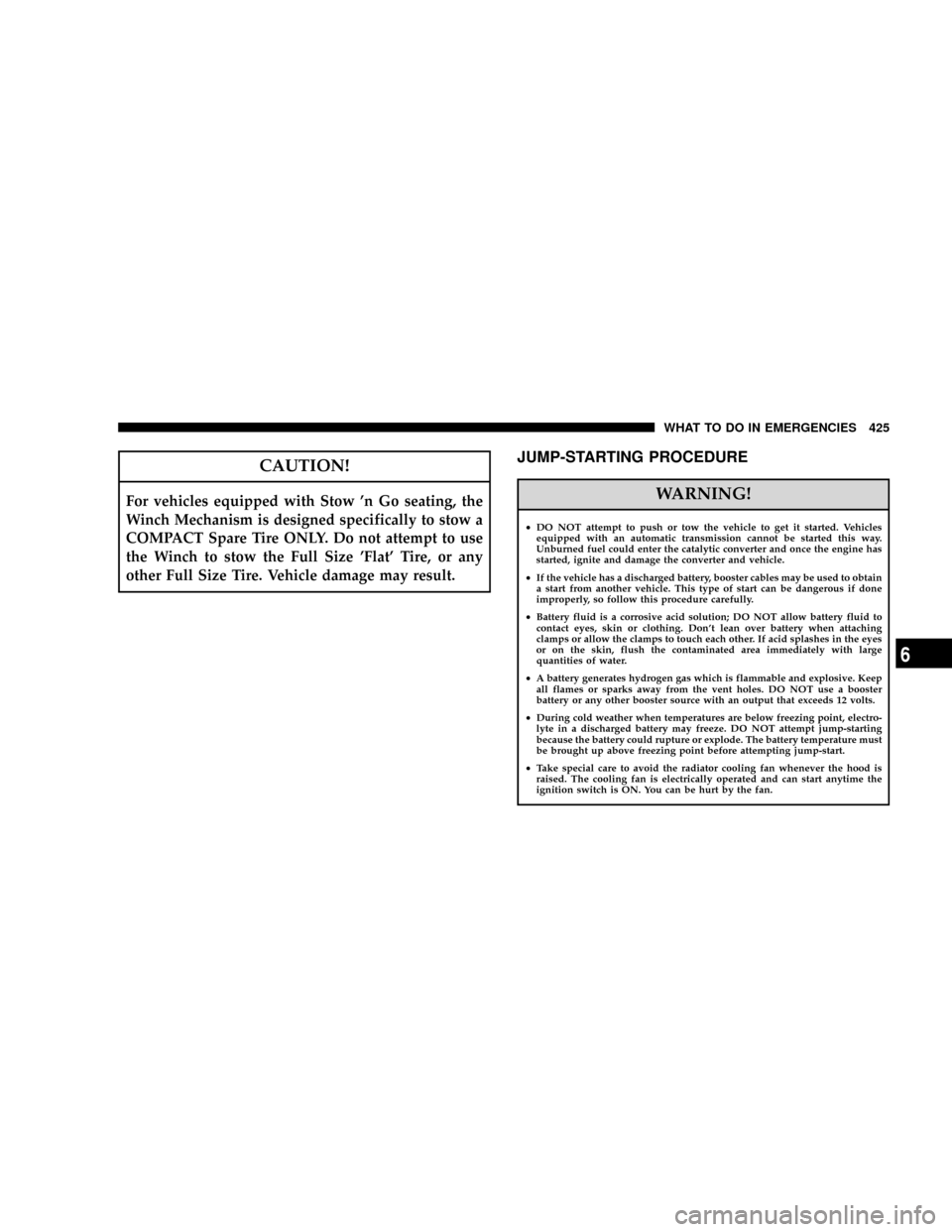
CAUTION!
For vehicles equipped with Stow 'n Go seating, the
Winch Mechanism is designed specifically to stow a
COMPACT Spare Tire ONLY. Do not attempt to use
the Winch to stow the Full Size 'Flat' Tire, or any
other Full Size Tire. Vehicle damage may result.
JUMP-STARTING PROCEDURE
WARNING!
²DO NOT attempt to push or tow the vehicle to get it started. Vehicles
equipped with an automatic transmission cannot be started this way.
Unburned fuel could enter the catalytic converter and once the engine has
started, ignite and damage the converter and vehicle.
²If the vehicle has a discharged battery, booster cables may be used to obtain
a start from another vehicle. This type of start can be dangerous if done
improperly, so follow this procedure carefully.
²Battery fluid is a corrosive acid solution; DO NOT allow battery fluid to
contact eyes, skin or clothing. Don't lean over battery when attaching
clamps or allow the clamps to touch each other. If acid splashes in the eyes
or on the skin, flush the contaminated area immediately with large
quantities of water.
²A battery generates hydrogen gas which is flammable and explosive. Keep
all flames or sparks away from the vent holes. DO NOT use a booster
battery or any other booster source with an output that exceeds 12 volts.
²During cold weather when temperatures are below freezing point, electro-
lyte in a discharged battery may freeze. DO NOT attempt jump-starting
because the battery could rupture or explode. The battery temperature must
be brought up above freezing point before attempting jump-start.
²Take special care to avoid the radiator cooling fan whenever the hood is
raised. The cooling fan is electrically operated and can start anytime the
ignition switch is ON. You can be hurt by the fan.
WHAT TO DO IN EMERGENCIES 425
6
Page 428 of 531

When jump-starting, proceed as follows:
1. Wear eye protection and remove any metal jewelry
such as watch bands or bracelets that might make an
inadvertent electrical contact.
2. When a boost is provided by a battery in another
vehicle, park that vehicle within booster cable reach and
without letting the vehicles touch. Set the parking brake,
place the automatic transmission selector lever into
PARK and turn the ignition switch to the OFF position for
both vehicles.
3. Turn OFF the heater, radio and all unnecessary elec-
trical loads.
4. Connect one end of a jumper cable to the positive
terminal of the discharged battery. Connect the other end
of the same cable to the positive terminal of the booster
battery.WARNING!
DO NOT permit vehicles to touch each other as this
could establish a ground connection and personal
injury could result.
5. Connect the other cable, first to the negative terminal
of the booster battery, and then to the engine of the
vehicle with the discharged battery. Make sure there is a
good contact on the engine.
WARNING!
DO NOT connect the cable to the negative post of the
discharge battery. The resulting electrical spark could
cause the battery to explode.
426 WHAT TO DO IN EMERGENCIES
Page 430 of 531
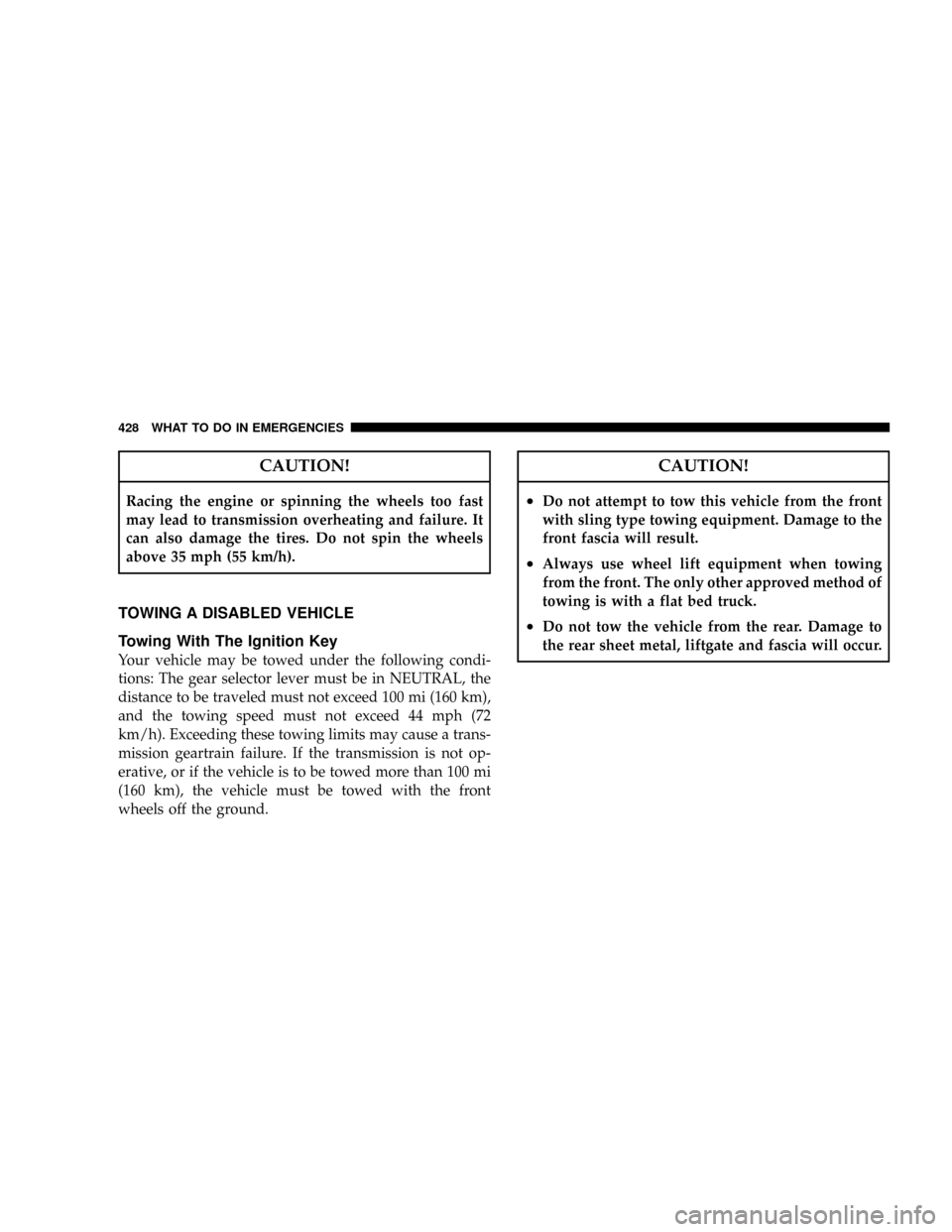
CAUTION!
Racing the engine or spinning the wheels too fast
may lead to transmission overheating and failure. It
can also damage the tires. Do not spin the wheels
above 35 mph (55 km/h).
TOWING A DISABLED VEHICLE
Towing With The Ignition Key
Your vehicle may be towed under the following condi-
tions: The gear selector lever must be in NEUTRAL, the
distance to be traveled must not exceed 100 mi (160 km),
and the towing speed must not exceed 44 mph (72
km/h). Exceeding these towing limits may cause a trans-
mission geartrain failure. If the transmission is not op-
erative, or if the vehicle is to be towed more than 100 mi
(160 km), the vehicle must be towed with the front
wheels off the ground.
CAUTION!
²Do not attempt to tow this vehicle from the front
with sling type towing equipment. Damage to the
front fascia will result.
²Always use wheel lift equipment when towing
from the front. The only other approved method of
towing is with a flat bed truck.
²Do not tow the vehicle from the rear. Damage to
the rear sheet metal, liftgate and fascia will occur.
428 WHAT TO DO IN EMERGENCIES
Page 431 of 531
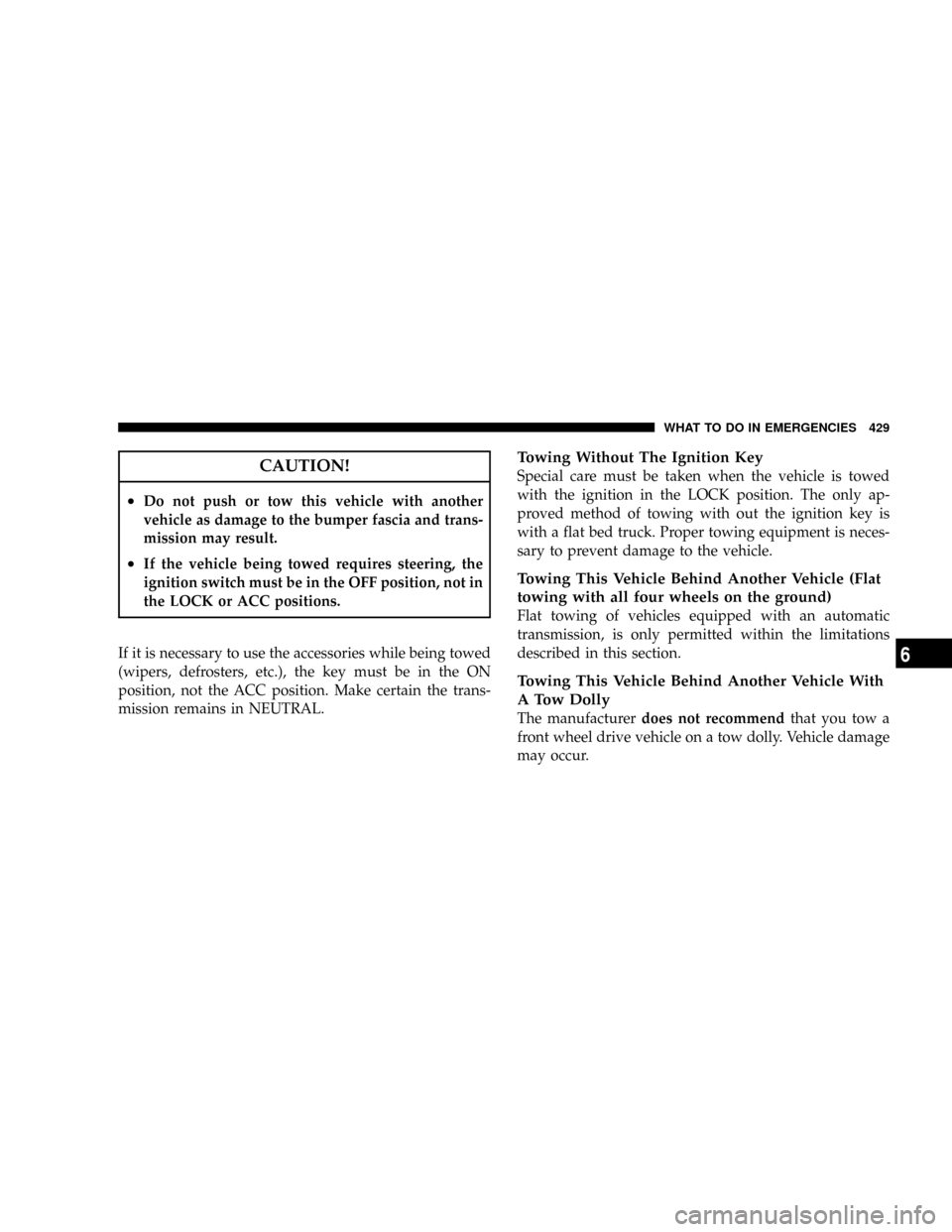
CAUTION!
²Do not push or tow this vehicle with another
vehicle as damage to the bumper fascia and trans-
mission may result.
²If the vehicle being towed requires steering, the
ignition switch must be in the OFF position, not in
the LOCK or ACC positions.
If it is necessary to use the accessories while being towed
(wipers, defrosters, etc.), the key must be in the ON
position, not the ACC position. Make certain the trans-
mission remains in NEUTRAL.
Towing Without The Ignition Key
Special care must be taken when the vehicle is towed
with the ignition in the LOCK position. The only ap-
proved method of towing with out the ignition key is
with a flat bed truck. Proper towing equipment is neces-
sary to prevent damage to the vehicle.
Towing This Vehicle Behind Another Vehicle (Flat
towing with all four wheels on the ground)
Flat towing of vehicles equipped with an automatic
transmission, is only permitted within the limitations
described in this section.
Towing This Vehicle Behind Another Vehicle With
A Tow Dolly
The manufacturerdoes not recommendthat you tow a
front wheel drive vehicle on a tow dolly. Vehicle damage
may occur.
WHAT TO DO IN EMERGENCIES 429
6
Page 441 of 531
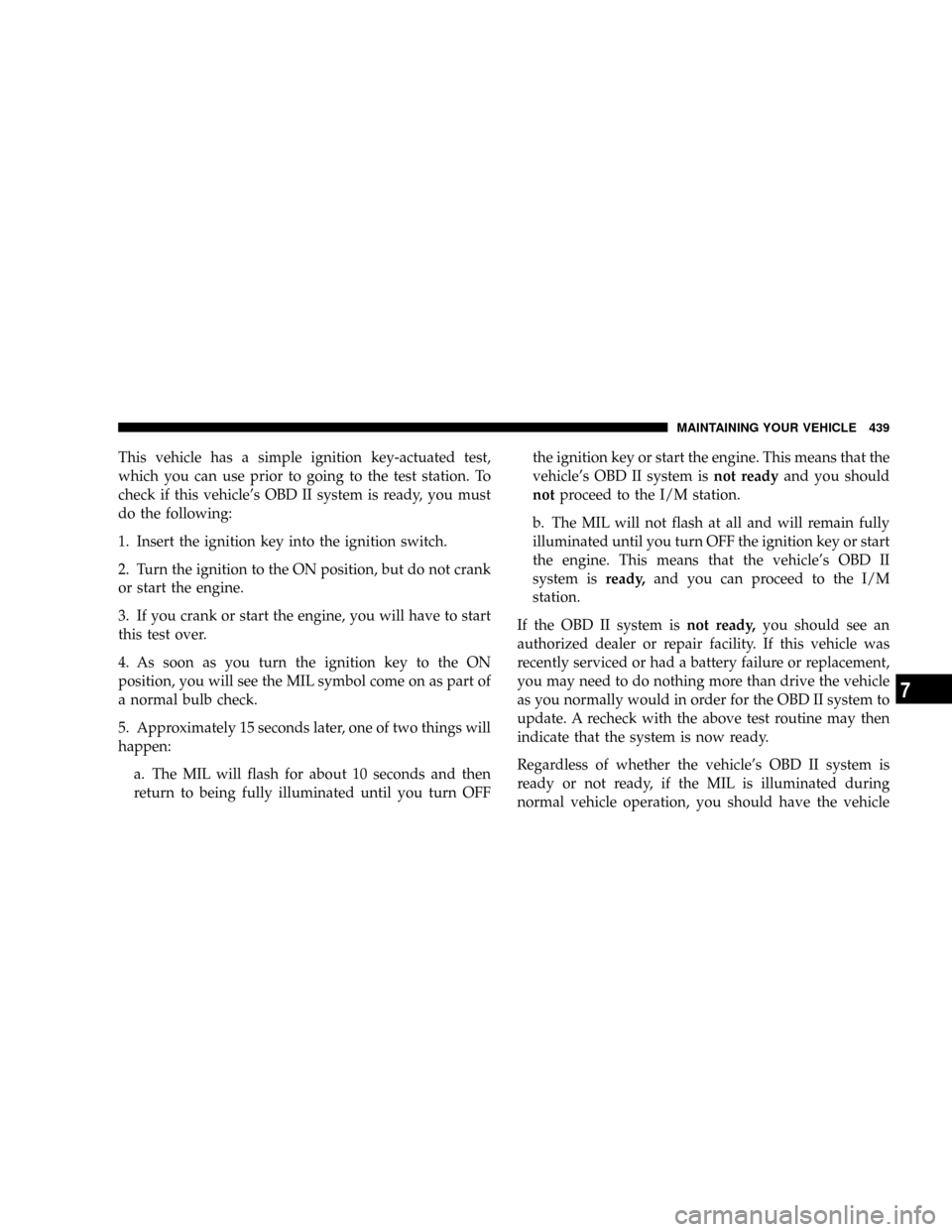
This vehicle has a simple ignition key-actuated test,
which you can use prior to going to the test station. To
check if this vehicle's OBD II system is ready, you must
do the following:
1. Insert the ignition key into the ignition switch.
2. Turn the ignition to the ON position, but do not crank
or start the engine.
3. If you crank or start the engine, you will have to start
this test over.
4. As soon as you turn the ignition key to the ON
position, you will see the MIL symbol come on as part of
a normal bulb check.
5. Approximately 15 seconds later, one of two things will
happen:
a. The MIL will flash for about 10 seconds and then
return to being fully illuminated until you turn OFFthe ignition key or start the engine. This means that the
vehicle's OBD II system isnot readyand you should
notproceed to the I/M station.
b. The MIL will not flash at all and will remain fully
illuminated until you turn OFF the ignition key or start
the engine. This means that the vehicle's OBD II
system isready,and you can proceed to the I/M
station.
If the OBD II system isnot ready,you should see an
authorized dealer or repair facility. If this vehicle was
recently serviced or had a battery failure or replacement,
you may need to do nothing more than drive the vehicle
as you normally would in order for the OBD II system to
update. A recheck with the above test routine may then
indicate that the system is now ready.
Regardless of whether the vehicle's OBD II system is
ready or not ready, if the MIL is illuminated during
normal vehicle operation, you should have the vehicle
MAINTAINING YOUR VEHICLE 439
7
Page 449 of 531
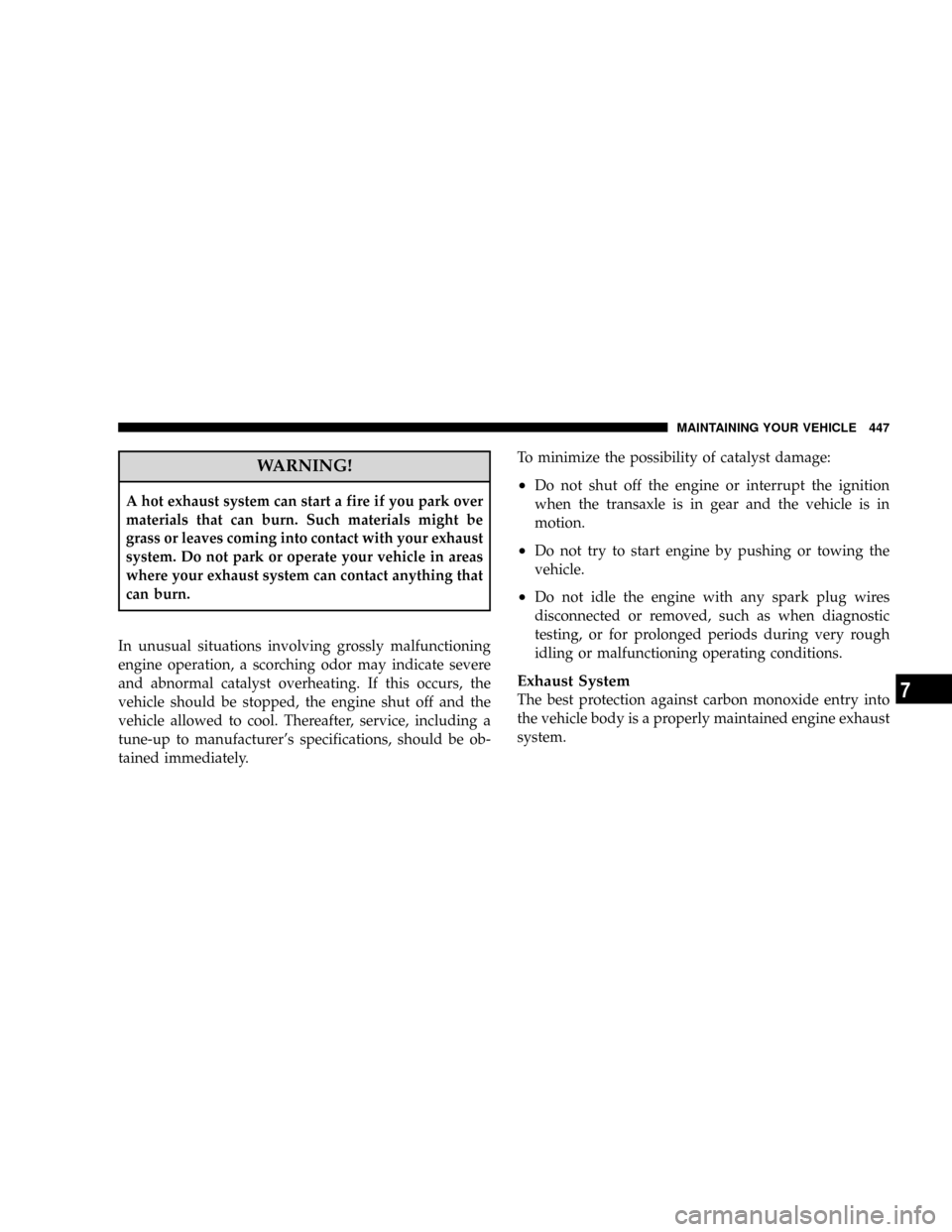
WARNING!
A hot exhaust system can start a fire if you park over
materials that can burn. Such materials might be
grass or leaves coming into contact with your exhaust
system. Do not park or operate your vehicle in areas
where your exhaust system can contact anything that
can burn.
In unusual situations involving grossly malfunctioning
engine operation, a scorching odor may indicate severe
and abnormal catalyst overheating. If this occurs, the
vehicle should be stopped, the engine shut off and the
vehicle allowed to cool. Thereafter, service, including a
tune-up to manufacturer's specifications, should be ob-
tained immediately.To minimize the possibility of catalyst damage:²Do not shut off the engine or interrupt the ignition
when the transaxle is in gear and the vehicle is in
motion.
²Do not try to start engine by pushing or towing the
vehicle.
²Do not idle the engine with any spark plug wires
disconnected or removed, such as when diagnostic
testing, or for prolonged periods during very rough
idling or malfunctioning operating conditions.
Exhaust System
The best protection against carbon monoxide entry into
the vehicle body is a properly maintained engine exhaust
system.
MAINTAINING YOUR VEHICLE 447
7
Page 458 of 531
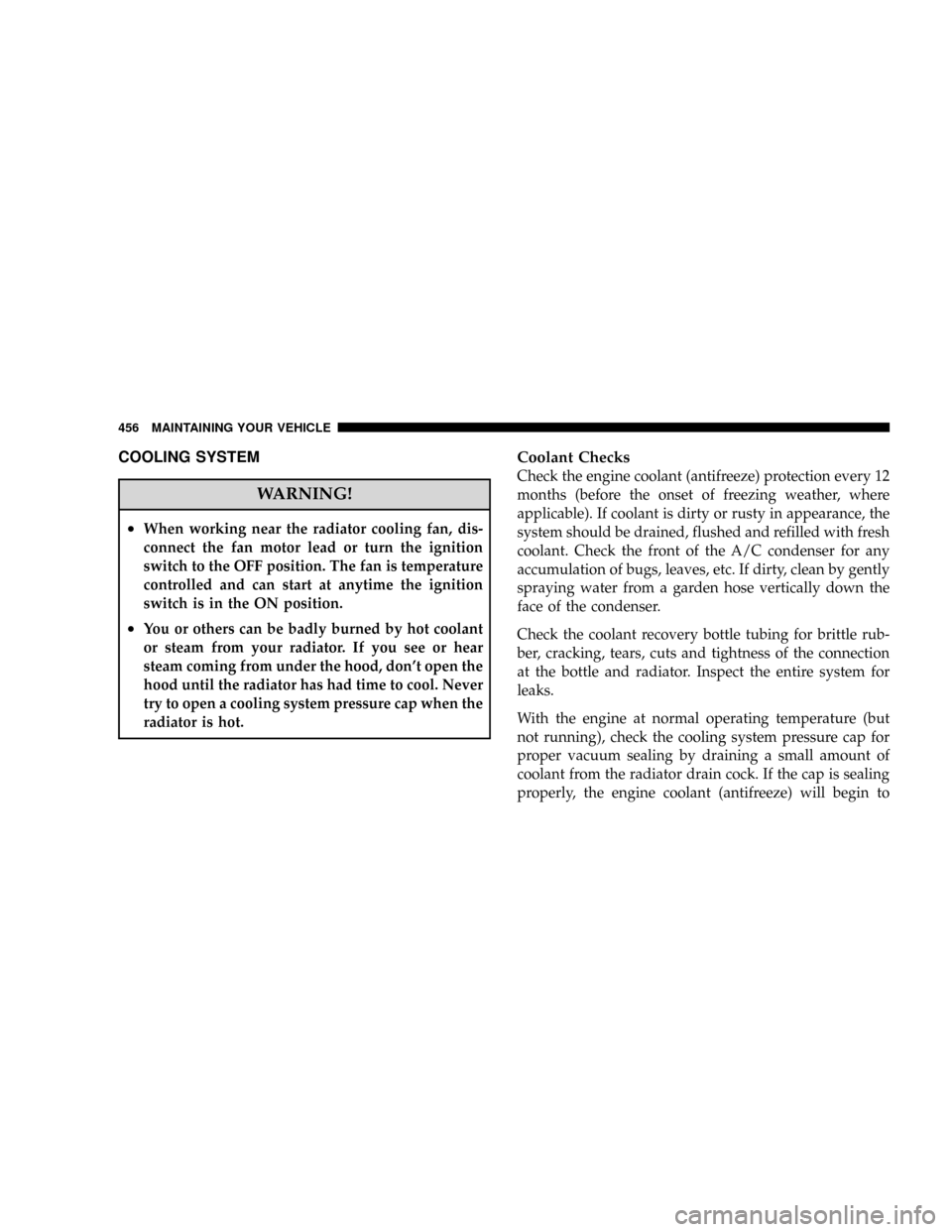
COOLING SYSTEM
WARNING!
²When working near the radiator cooling fan, dis-
connect the fan motor lead or turn the ignition
switch to the OFF position. The fan is temperature
controlled and can start at anytime the ignition
switch is in the ON position.
²You or others can be badly burned by hot coolant
or steam from your radiator. If you see or hear
steam coming from under the hood, don't open the
hood until the radiator has had time to cool. Never
try to open a cooling system pressure cap when the
radiator is hot.
Coolant Checks
Check the engine coolant (antifreeze) protection every 12
months (before the onset of freezing weather, where
applicable). If coolant is dirty or rusty in appearance, the
system should be drained, flushed and refilled with fresh
coolant. Check the front of the A/C condenser for any
accumulation of bugs, leaves, etc. If dirty, clean by gently
spraying water from a garden hose vertically down the
face of the condenser.
Check the coolant recovery bottle tubing for brittle rub-
ber, cracking, tears, cuts and tightness of the connection
at the bottle and radiator. Inspect the entire system for
leaks.
With the engine at normal operating temperature (but
not running), check the cooling system pressure cap for
proper vacuum sealing by draining a small amount of
coolant from the radiator drain cock. If the cap is sealing
properly, the engine coolant (antifreeze) will begin to
456 MAINTAINING YOUR VEHICLE
Page 477 of 531
FUSES/TIPM
CavityCartridge
FuseMini
FuseDescription
J1 40 Amp
GreenÐ Power Folding Seat
J2 30 Amp
PinkÐ Power Liftgate Module
J3 40 Amp
GreenÐ Rear Door Module (RR
Door Node)
J4 25 Amp
NaturalÐ Driver Door Node
J5 25 Amp
NaturalÐ Passenger Door Node
J6 40 Amp
GreenÐ Anti-Lock Brake System
(ABS) Pump/ESP
J7 30 Amp
PinkÐ Anti-Lock Brake System
(ABS) Valve
J8 40 Amp
GreenÐ Power Memory Seat (If
Equipped)
J9 40 Amp
GreenÐ PZEV Motor/Flex FuelFUSES/TIPM
CavityCartridge
FuseMini
FuseDescription
J10 30 Amp
PinkÐ Headlamp Wash Relay/
Manual Tuning Valve
J11 30 Amp
PinkÐ Power Sliding Door
Module
J13 60 Amp
YellowÐ Ignition Off Draw (IOD)
Ð Main
J14 40 Amp
GreenÐ Rear Window Defogger
J15 30 Amp
PinkÐ Rear Blower
J17 40 Amp
GreenÐ Starter Solenoid
J18 20 Amp
YellowÐ Powertrain Control Mod-
ule (PCM) Trans Range
J19 60 Amp
YellowÐ Radiator Fan
J20 30 Amp
PinkÐ Front Wiper LO/HI
MAINTAINING YOUR VEHICLE 475
7